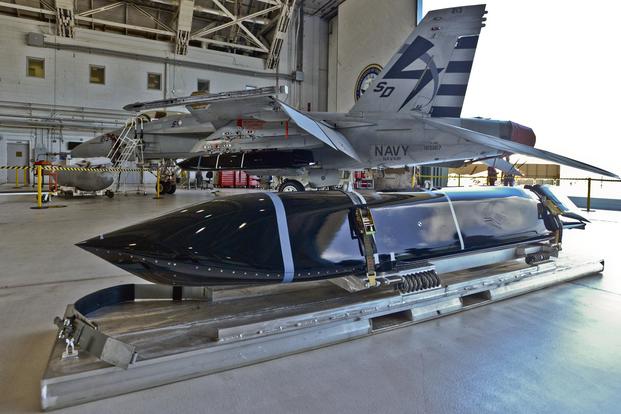NATIONAL HARBOR, Md. -- The F/A-18 Super Hornet is gearing up to live-test Lockheed Martin Corp.'s Long Range Anti-Ship Missile (LRASM), with a range test expected this year, a company executive told Military.com on Tuesday.
"Right now, we're doing captive-carry testing, and we'll have the first live shot off the F-18 later this year," said Alan Jackson, Lockheed's vice president of strike systems.
The AGM-158C LRASM will then become operational in September 2019, he said. Jackson spoke with Military.com during the annual Sea-Air-Space exposition here.
An F/A-18E/F Super Hornet successfully conducted a "jettison release" test at Naval Air Station Patuxent River, Maryland, last year. The move paved the way for the ongoing captive-carry tests at Navy Air Weapons Station China Lake, California, Lockheed said at the time.
Related content:
- New Precision Weapon Allows F-35C to Destroy Targets in Stealth Mode
- US Launches Cruise Missile Strike on Syria
- B-1 Crews Prep for Anti-Surface Warfare in Latest LRASM Tests
The precision-guided, anti-ship standoff missile is expected to be fielded first on the B-1B Lancer bomber. In December, B-1 crews launched LRASM at Point Mugu Sea Range, California. It was first tested on a B-1B in August.
"This is the anti-surface warfare the Navy was looking for," Jackson said. "Flight testing is going well. We're six for six [successful tests] on the B-1 program."
Two more flights are expected this summer before the missile is operationally fielded on the non-nuclear bomber in September, Jackson said.
The Air Force and Navy are working together to streamline the testing process as it applies to each of their aircraft, he said.
"We have a greater-than-200 nautical mile standoff range," Jackson said. "So either one of those platforms is out of harm's way when it releases the weapon."
LRASM can also be deck-launched from a vertical launch system on a Navy destroyer, he said.
In comparison to the Tomahawk cruise missile, LRASM has a better survivability rate because it has low-observable technologies making it harder to detect. "Tomahawk is a fine weapon, but it's an older design," Jackson said.
LRASM was an easy fit for the B-1 because it can already launch the Joint Air-to-Surface Standoff Missile-Extended Range, known as JASSM-ER.
The missile has all the capabilities that JASSM-ER has: the same lethal 1,000-pound warhead, pinpoint accuracy with an infrared sensor, and both GPS and anti-jam navigation. But the LRASM can detect, identify and attack moving, maritime targets.
"LRASM also has a datalink on board that gives it more flexibility," Jackson said, allowing it to communicate with its launch platform.
"We're in Block 1 production for LRASM now," he said, adding there’s an Air Force contract requirement of 23 missiles thus far. "We certainly can build at a rate faster than 23, and I see those rates increasing as we go into lot 2, 3 and 4."
-- Oriana Pawlyk can be reached at oriana.pawlyk@military.com. Follow her on Twitter at @Oriana0214.










